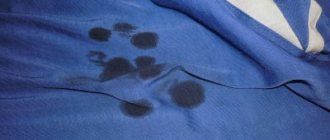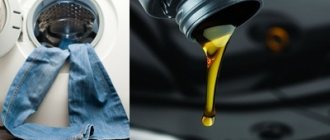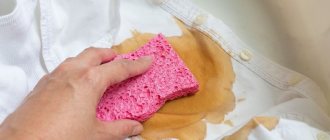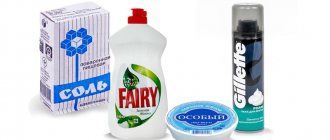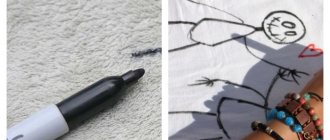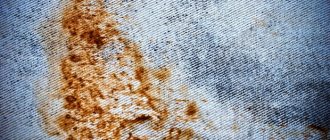During repairs, did the swallows get dirty with machine oil? The problem is known and a solution for it has long been found! In this article we will tell you how to remove machine oil from clothes in a variety of ways.
About the problem in general
Regular washing with powder and soaking will not help here, and a fresh stain can stain an adjacent area of fabric or the drum of the washing machine. To remove oil, you will need aggressive chemicals that can ruin your clothes. Therefore, it is better to carry out preliminary testing by applying the composition on the wrong side of the seam or hem. They must be used carefully, using rubber gloves.
There is no point in rubbing an oil stain with a dry cloth or brush without a cleaning agent. The fat will only be spread over the surface and absorbed deeper into the material. It’s better not to rack your brains than to wash off machine oil, but to use one of the methods given, taking into account the characteristics of the material.
Important: as soon as a stain appears, you should immediately blot it with a paper towel or clean rag to avoid further spread. After this, start making a print.
Using caustic soda
This is a last resort if other methods have failed and if the engine oil is particularly thick and corrosive. In this case, you need to act with extreme caution. Hands must be wearing latex gloves.
Preparation of the mixture:
- To remove stains, you need to take dry lye flakes and dilute them with cool water to a paste.
- The chemical reaction will be accompanied by the release of a large amount of heat, so the risk of getting a burn has not been canceled.
- After complete dissolution, you need to try the effect of the mixture on an inconspicuous area.
- Apply the mixture with gloved hands, rub and rinse off.
- After processing the fabric, it must be rinsed thoroughly and finally treated with water acidified with vinegar or citric acid.
- Rinse in clean water or with rinse aid.
- Dry as usual.
Synthetic fabrics usually do not withstand such influences well, while natural ones can withstand literally several times. But at the same time you can easily eliminate greasy stains.
Removal from jacket
- Blot a fresh stain on the surface of a synthetic jacket with a rag and squeeze a little dishwashing detergent onto it. Do not rub the gel in and leave it on the fabric for 15-30 minutes. Blot with napkins until traces disappear and machine wash with powder.
- Remove oil stains on bolognese clothing or a down jacket using a solution of ammonia. To do this, add a teaspoon of ammonia to 100 ml of water. Treat the dirty area and leave for an hour. Rinse with running water and wash with detergent. You should not experiment with undiluted alcohol to prevent the fabric from fading.
Important: adding washing powder to the dish gel will enhance the cleaning effect.
Cotton jacket
- Kerosene successfully removes machine oil prints from natural fabrics. The substance is poured directly onto the stain, and then collected with a cloth in the direction from the periphery to the center so as not to leave streaks. All that remains is to wash the jacket with detergent.
- Mustard powder will help remove motor oil from cotton. You will also need a brush, soap and warm water. Rub the fabric with soap and sprinkle powder onto the stain. Moisten the brush with water and rub the dirt. Rinse.
- Light-colored cotton jackets are cleaned by sequentially using three components: hydrogen peroxide, baking soda and dishwashing liquid. Peroxide is applied to the entire surface of the stain and covered with a thick layer of soda. Pour dishwashing gel evenly over the components and sprinkle with baking soda again. Rub the area with an old toothbrush and leave for an hour. Without rinsing off the composition, wash with detergent.
- For dark clothes, activated carbon, crushed to a powder, is suitable. Sprinkle it on the stain and wait until the oil composition is absorbed.
Suede
- Gasoline is suitable for cleaning dark and light suede material. It is enough to place napkins soaked in gasoline on both sides of the machine oil stain. Leave for effect. After about half an hour, the napkins will be saturated with oil and the clothes will be clean. Now you just need to wash the surface with detergent and dry.
- Treat the suede with car oil stain remover spray. The product perfectly copes with old and stubborn dirt, and very quickly.
- Sprinkle starch or talc onto a fresh oil stain to absorb the grease. After some time, remove the residue with a brush.
How to get rid of machine oil stains
If it has not yet had time to dry and be completely absorbed into the fibers, then these steps will help you quickly get rid of the problem.
What do we have to do:
- Place a piece of cardboard behind the stain on your item of clothing.
- Apply dishwashing liquid to break up oil and grease.
- Spray the baking soda solution to remove the stain from the fabric. For 1 liter of water add 2 tbsp.
- Use a toothbrush to get the baking soda deep into the fibers.
- After waiting five to ten minutes, place the item in the washing machine as usual.
If the T-shirt is white, it is better to dry it in direct sunlight.
Removing stains from denim
- To clean, traces of oil on jeans are treated with a solvent, and then rubbed with a brush with washing powder, which is poured onto the fabric and moistened. Use the technical product carefully so that the color of the product does not change.
- In some cases, a mixture of ammonia and turpentine is effective for denim. It is applied to the dirty area and wiped with a cloth. Wash clothes in soapy water several times until the smell is removed.
- Rub the machine oil stain with a bar of laundry soap and clean thoroughly with a stiff brush. Repeat until the oil mark disappears.
Tip: traces of soda, starch or chalk are easily removed during the washing process. Therefore, the grains remaining after cleaning are not a problem.
The use of folk remedies
Folk remedies help get rid of both old and fresh stains. Before using any of these methods, it is advisable to first try on a less visible area of clothing. The most effective means:
- Petrol. You will need a product purchased at a hardware store. Standard gasoline from a gas station will not help. It is necessary to place the item in a basin and thoroughly treat the contaminated area with the solution. Leave for 5-10 minutes. Then wash in soapy water. This method can harm silk fabric.
- Turpentine and ammonia. This mixture is best used for cleaning white fabrics. It is necessary to take both ingredients in equal proportions and mix. Apply the resulting product to the contaminated area, after wearing rubber gloves. After 15 minutes you can start washing.
- Mustard. This method is suitable for dark fabrics. You will need mustard powder, which must be dissolved with warm water to obtain a paste. Then apply to the stain and leave for half an hour. Then rinse thoroughly in warm water.
- Dentifrice. This product is only effective for removing fresh stains. The contaminated area should be generously sprinkled with tooth powder and left for half an hour. Then wash the item.
- Butter. It must first be melted. Then rub into the stained area and leave for 20 minutes. After this, wash the item using dishwashing detergent. Suitable for different types of fabrics and fresh stains.
Removing a fresh stain from machine oil will require a minimum of effort and time, but dealing with old stains is very difficult and in most cases you cannot do without the help of dry cleaning.
From T-shirts
- A T-shirt smeared with machine oil during car repairs can be washed off with tar soap. The cloth in the affected area is moistened and soaped. For best effects, you need to hold it for 1-2 hours. Then wash with powder.
- The WD-40 aerosol familiar to motorists can remove machine oil on knitted clothing. He will also need baking soda and dish gel to help. Apply the spray liberally to the dirt, sprinkle with baking soda and rub. The baking soda that has absorbed the oil will begin to clump. The procedure must be performed 2-3 times. Finish by rubbing in dishwashing detergent and washing with powder.
- Knitwear made of delicate fabric that cannot be rubbed, it is recommended to remove traces of machine oil with hairspray. Spray a small amount onto the stain, and then wash with a product suitable for this type of fabric. The whole secret is in the alcohol that can dissolve the oil, which is contained in the varnish.
Important: You can only use the automatic clothes dryer if the stain no longer exists. Exposure to hot air fixes the mark on the surface.
Rules for removing oil from clothes
There are several standard rules that help remove any stain:
- The sooner the stain is noticed, the better. It is advisable to start washing immediately when it first appears. Even if this happened on the street, you need to have at least a simple dishwashing detergent in stock.
- To prevent the stain from covering a large area, you need to sprinkle it with salt or starch. You can also use crushed chalk. It will absorb most of the oil and at least the stain will not increase. You can increase efficiency by placing these products in the microwave; hot elements absorb fat perfectly.
- Do not immediately soak the item and wash it in hot water. The stain will become larger and cannot be removed.
- If the stain is old and the item is colored, you should not immediately use strong chemicals. First you need to take a small piece of fabric and test the product on it; often such compositions corrode the paint.
It is better to work with strong products while wearing gloves.
Sweater
- Use a wool stain remover.
- You can remove engine oil prints using denatured alcohol and turpentine. Mix the components in equal parts and apply to the stain with a cotton pad. Repeat the treatment until the stain disappears and wash the item as usual.
- Hot water, which breaks down fat well, cannot be used for woolen sweaters. It will be replaced by corn starch and dish gel. Cover the stain with starch powder in a dense layer. After 30-60 minutes, clean the item with a brush. Apply dish gel to the remaining mark and spread with your finger. Meanwhile, fill a basin with cold water and foam a little product in it. Immerse the sweater completely and leave for 15-20 minutes. Wash without twisting or stretching, rinse until clean. Let drain and wring out with a towel. Dry flat.
- Salt can save a sweater from the fibers absorbing oil and spreading it. A fresh stain is generously covered with salt. As a good absorbent, it will absorb liquid and after that a simple wash will be enough.
Advice: when using technical equipment, you should work in a ventilated area. Place a cotton cloth or piece of cardboard under the stain to avoid transferring to another surface.
Does the brand of oil matter?
Machine oil is made up of different chemical elements. It can be used for different purposes, therefore, the composition may vary depending on the brand. Understanding the composition, you can wash any thing, even the most contaminated rag.
What types of oils are most often used by car enthusiasts:
- Mineral - made using conventional distillation;
- Synthetic - with the addition of oil;
- Semi-synthetic - adding synthetics within 20%.
Any oil is made from petroleum products and is chemically stable. Therefore, the tips below will help you cope with any type. The most difficult spots are those caused by cycling in the rain.
Here, road oil mixes with dust and it is impossible to tell what type was used. However, even this stain can be washed off as recommended.
From tracksuits, trousers
- Sportswear can be washed with any of the degreasing agents. Solvent, acetone or nail polish remover will do. Wipe the machine oil stain with a sponge soaked in any of the chemicals. Leave for 30-40 minutes and wash with regular detergent.
- Mix magnesia powder with ether until paste-like. Cover the contaminated area of the pants completely with the paste and rub into the fabric with gentle movements.
- A wool tracksuit is restored after oil contamination with a special solution of dish gel, white vinegar and warm water. The proportion is maintained 1:1:6. Apply the mixture to the stain and carefully scrub it off with a toothbrush. Leave for 5-7 minutes and blot the composition with a damp and dry towel.
Cleaning off silicone grease
This white translucent substance can be found on the factory floor and in normal everyday life. Thanks to it, rubber parts found in various parts are less damaged. Silicone grease can be found in equipment used in various fields, for example, dentistry or printing.
It is used by plumbers and laboratory chemists. At home, it is used for lubricating locks, hinges, seams, sealing and sealing. The tightness determines its frequent use for repair and construction purposes. It is not surprising that such grease often ends up on clothes and other things.
Vinegar is suitable for cleaning acid-based grease. First, we protect ourselves with goggles, a respirator and gloves, treat the problem area with acetic acid (70%), and after half an hour we get rid of traces of silicone with a clean cloth.
Be sure to work carefully so that acetic acid vapors do not harm the skin of your hands, mucous membranes and respiratory tract. An alcohol-based substance can be removed from fabric with alcohol (technical, denatured, medical) or regular vodka. Soak a clean cloth in alcohol and apply it to the stained area until pieces of silicone begin to come off the material.
What is silicone?
This substance belongs to rubber mixtures. Silicone has adhesive and adhesive characteristics. The main property of silicone grease is that it can penetrate even microscopic cracks and gaps. That’s why it’s so difficult to wash, because the substance quickly penetrates between the fibers of the fabric.
The advantages of the product include:
- The substance instantly hardens, which, meanwhile, complicates the washing process.
- The substance is heat-resistant, which also makes cleaning difficult.
- The substance is moisture-resistant, which does not allow you to simply wash the products in powder.
- Silicone is very elastic.
For all their positive qualities, they make sealants very difficult to wash off.
There are only two varieties of this tool:
- A substance that contains acids. Their distinctive feature is the characteristic smell of vinegar.
- Products that are neutral in their chemical composition.
